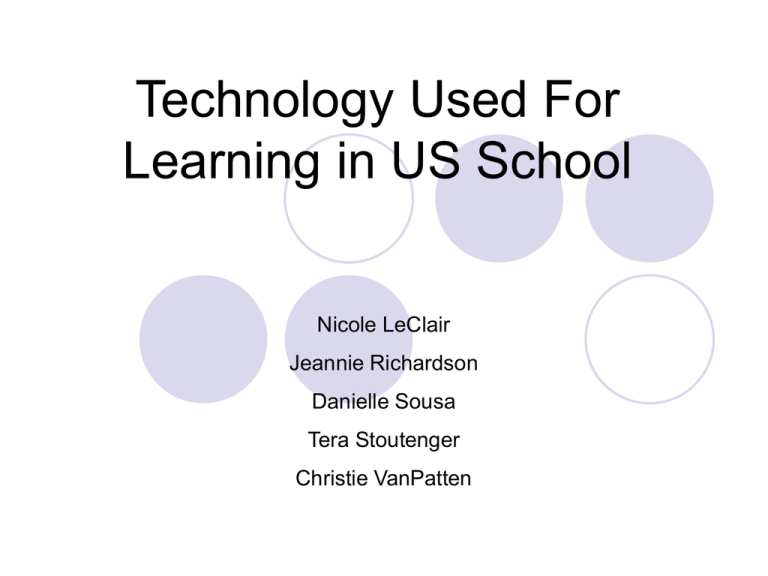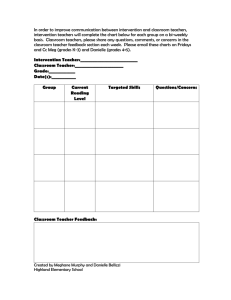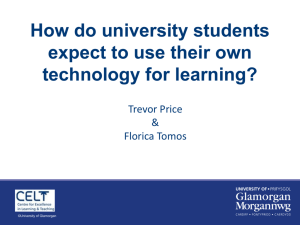Technology Used For Learning in US School
advertisement

Technology Used For Learning in US School Nicole LeClair Jeannie Richardson Danielle Sousa Tera Stoutenger Christie VanPatten Jeannie Richardson The history of technology in education has come a long way over the years. Technology being used for education has gone through many different changes to continuously improve education. Many schools over the years have started to implement technology into their curriculum because they realize computers and technology are our future. History of Technology in US Schools 1963 - Vocational Education Act passes with new money supporting the use of technology in schools 1965 - Elementary and Secondary Education Act brings new money into schools for technology 1986 - 25 % of high schools use PCs for college and career guidance 1995 - The Internet and the world wide web began to catch on as businesses, schools, and individuals create web pages Computers in Schools According to the National Center for Education Statistics, only 3% of public schools offered instructional rooms with internet access for their students in 1994 compared to 87% in 2001. That is a huge change in such a short amount of time and this shows how much progress has been made in the history of technology. Technology Integration Technology integration is the selection of appropriate tools, resources, techniques, and systems to promote and support student learning Some of the resources that schools use are content-specific instructional software, e-mail, online courses, and the internet. Educational technology has evolved from the ancient abacus to the calculator, and now to the computer. How is Technology Used in Schools? Educators are using computers to put drills on overhead projectors or using word processors to create tests. How is technology beneficial for schools? Most students have a computer in their house or they have access to one so they can work on projects at home or finish up work they couldn’t finish in class. By connecting to their school network, students can extend their learning. Parents have access to teacher’s web-pages and e-mail address so they can stay in contact with teacher and find out what student should be learning. Students can work at their own pace How is technology harmful for schools? Cheating is much easier with the use of cell phone and Ipods Students have become too dependent on the internet and don’t do enough of there own work Technology is Expensive School systems nationwide spent an estimated 6.9 billion dollars on personal computers, servers, internet access, software, and other implements in order to make technology available There is still going to be some obstacles in implementing technology in education. Schools need the proper funding to put technology into their schools because technology is very expensive and the schools with less money to spend particularly city schools will be behind other schools that have more money to spend on their technology. Work Cited “History, the History of Computers, and the History of Computers in Education”. April 18, 2007. <http://www.csulb.edu/~murdock/histofcs.html> “Technology Use In Rural High Schools Improves Opportunities for Student Achievement.” March 2005. Southern Regional Education Board. April 20, 2007. <http://www.sreb.org/programs/EdTech/pubs/PDF/05T01TechnologyUseinRuralHS.pdf> Nicole Le Clair Cell phones a hand-held mobile radiotelephone Can be either used for talking or texting Texting is a form of communicating through typed words from cellular to another. popular device among adolescents and young adults http://www.mobiledia.com/news/38157.html http://www.engadget.com/2006/02/02/veri zon-gives-in-allows-dun-from-cellphones/ Advantages of Cell phones “ Is there anything students can learn on a voice-only phone? Languages, literature, public speaking, writing, storytelling, and history are just a few of the subjects that are highly adaptable to voice-only technology,” Marc Prensky Schools can incorporate the newer technology to better serve the students and the vastly changing technology generation. The phone has the use for social interaction Marc Prensky’s idea is the phone can be transformed into a useful tool, instead of being an annoyance. Disadvantages of Cell phones Distraction for teenagers Cheating in classrooms during exams Harder for older teachers and professors to catch the cheating in action Example: in Texas, a professor unplugged the wireless connection in the classroom, so the students would pay attention In most college syllabuses, it is common to read that if a cell phone is found during a test on a individual, it will result in an automatic zero on that exam. The result in some schools, is a ban on the device on campus. Work Cited Alexander, Bryan. "Going Nomadic: Mobile Learning in Higher Education." Educause Review 39.5(2004) 28-35. 03302007 <http://www.educause.edu/pub/er/erm04/erm0451.asp?bhcp=1>. Aoki, Kumiko and Edward J. Downes. "An analysis of young people's use of and attitudes toward cell phones." Telematics and Inforamatics 03062003 349-64. 03302007 . Dillip, Bobb, Datta Damayanti, and "Wired Generation; Today's teenagers are causing concern because of the hours they spend multi-tasking with their gadgets, TV and the Net. Is their obession with technology a positive or negative factor?." India Today 11202006 48. 03302007 . Ling, Rich. "The Mobile Connection: The Cell Phone's Impact on Society." International Journal of Technology and Human Interaction 1(2005): 101-04. Prensky, Marc. "What Can You Learn from a Cell Phone? Almost Anything! ." Innovate 1.5. 06132005 30032007 http://www.elearningsource.info/elearning/What%20Can%20You%20Learn%20from% 20a%20Cell%20Phone.pdf>. • Flexibility • Cost • Accessibility • No Travel Expenses • Self-Directed • Better for Some Learners • No Instructor Face Time • No Social Interaction • Making Time • Little Support • No Campus Atmosphere • Requires New Skills/Technologies Work Cited Hansen, Randall. “Distance Learning Pros and Cons.” Quintessential Careers. 4 April 2007. http://www.quintcareers.com/distance_learning_pros-cons.html Danielle Sousa Computers and Internet Research in Schools Pro’s and Con’s Danielle Sousa Computers in Schools, Pro’s Computer knowledge and skills are becoming more of a necessity. Fast and effective for doing work Research found that having a computer in the room to teach (using powerpoint) is beneficial for the students learning (Alexander, 96). Computers in Schools, Con’s The students can become reliant on computers and this can negatively effect their learning. Students may use the computers for things that don’t relate to class, which becomes a distraction. Computers are not always reliable and students work may get lost if unsaved. Researching on the Internet- Con’s The information found may not be reliable Students are more likely to plagiarize A study found that 80% of the best students are plagiarizing to get to the top and 53% say its not a big deal. (Fisher, 18). Search results are unevaluated and unorganized Students may rely on internet research and they may not know how to effectively research sources that are not on the internet. Researching on the Internet- Pro’s It’s fast and easy to research topics. You find can easily find something that you want to learn about. There are some very reliable and great sources found on the internet. The more students research, the more they learn how to use internet research and they can avoid some of the cons, like unreliable sources. References Alexander, B. “Using technology in teaching and learning: Resources to help you navigate a digital world.” College & Research Libraries News 68.2 (2007): 96-101 "Science and Technology: Pass the Chalk; Computers in School." Editorial. The Economist 365.8296 (2002): 106+ . Fisher, Julieta D., and Ann Hill. "PLAGIARISM in an Electronic Age." Library Media Connection 23.3 (2004): 18-19. Harris, Robert. "Evaluating Internet Research Sources." 17 November 1997. Online. Internet. [10 April 10, 2007] Available WWW: http://www.virtualsalt.com/evalu8it.htm Kelley, Frank. "School Renovation That Supports Learning & Technology." Media & Methods 41.3 (2004): 31-37 "Science and Technology: Pass the Chalk; Computers in School." Editorial. The Economist 365.8296 (2002): 106+ . Christie Van Patten How technology has improved communication in schools. How technology has improved communication in schools. -The internet, e-mail, and Instant messaging programs are largely used by people around the world to communicate when they are not able to see the person they need to talk to. (i.e. MSN, Yahoo Messenger, AIM, e-mail services, text messaging, and etc.) -Though it is argued that these forms of communication take away some important face to face elements it is believed they are more helpful than harmful. In an article the NEA reported that, “We as teachers and students need access to laptops and pocket PCs, digital cameras and microscopes…” As students these things are essential to us. For example, if you are a business major many of the classes require you to have a laptop. Due to assignments and open laptop quizzes - - Using communications is a large part of keeping up on technology. This PowerPoint presentation is a great example of online communication and the collaboration that occurred due to it. Teams can send one another their files via e-mail or through a messaging programs. Then once one person has all of the files they can put them together and create the final product. If questions arise communications is just a phone call, click of the mouse, or a few taps of the keyboard away. An article written by James Morrison said that students are now entering a world that has 60 % of jobs that will require technological competency. Works Cited National Education Association. “Technology and Education.” 2002-2006. http://www.nea.org/technology/index.html Morrison, James L. “Technology Tools for Today’s Campuses.” Chapel Hill, NC. May 1997. http://horizon.unc.edu/projects/monograph/CD/





